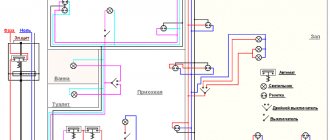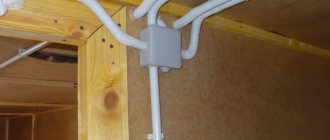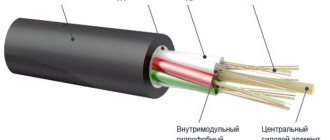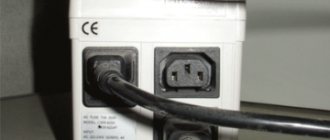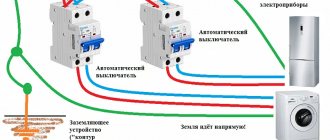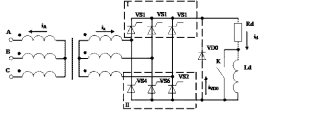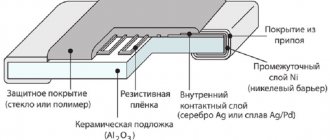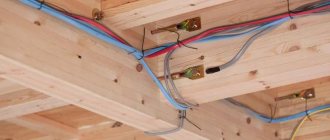An obligatory part of renovation work in an apartment is the replacement or installation of electrical cables, junction boxes, and electrical panels. A well-chosen electrical wiring diagram will protect your home from accidents and unforeseen situations.
We will tell you what you need to consider when replacing or installing electrical wiring yourself. Here you will learn how to draw up a diagram and distribute electrical points in one-room, two- and three-room apartments. Taking into account our recommendations, you can provide yourself with a trouble-free energy network.
Electrical wiring installation methods
Open wiring
Open wiring is not considered the best option for apartments and houses.
But as an exception, it may well be used. Therefore, we will briefly discuss the basic standards for installing this type of electrical wiring, its advantages and disadvantages. So:
- Open wiring is wiring that is laid directly on the surface of walls, ceilings and other building structures. It is performed in pipes, metal sleeves, boxes, trays or on insulators and cables. The choice of installation conditions depends on the wishes and technical characteristics of the room. In apartments, laying in boxes or trays is usually used, and individual branches can be made on rollers or insulators.
- According to the PUE standards (Electrical Installation Rules) clause 2.1.61, boxes and trays must be selected in such a way that the sum of the cross-sections of all wires laid in them does not exceed the cross-section of the box by more than 40%. In addition, according to SNiP 3.05.06 -85, boxes and trays must be made in such a way as to prevent the possibility of moisture accumulation.
When installing boxes, your apartment wiring diagram should take into account the following factors:
- When laying parallel to the pipeline, the distance between it and the tray must be at least 100 mm.
- When laying parallel to the gas pipeline, the distance between it and the wiring must be at least 400 mm.
- When laying electrical wiring closer than 250 mm from the pipeline, it is necessary to provide protection for the wire from mechanical damage.
- When crossing unprotected pipeline wires, it is necessary to ensure a distance between them of at least 50 mm.
- When crossing wires with gas pipelines, the distance between them must be at least 100 mm.
Laying wires in boxes requires compliance with the following conditions:
- Wires can be mounted scattered or in bundles.
- Individual cables or bundles must be attached to the box. In this case, it is necessary to provide a dielectric flexible gasket between the fastening and the wire. Usually it's rubber.
- Where trays pass through walls, wires must also have a fireproof seal. This is necessary to prevent the development of a possible fire. In this case, it must be possible to replace the wires.
Our instructions also include laying wires in baseboards as an open type of wiring. This type of gasket has recently become increasingly popular, but has a number of limitations. First of all, it is connected to a small number of wires that can be mounted behind the baseboard. Therefore, this type of installation can only be used as wiring around the room.
Open wiring
Now let's look at the advantages and disadvantages of the open wiring method.
The disadvantages include the following:
- Higher price of necessary materials. After all, in addition to the wire itself, you will need trays, metal corrugated hoses, seals and much more.
- They always try to hide utility lines. With the open method of laying the wires, they are visible, which does not improve the appearance of your apartment. In addition, boxes and trays hide free space.
- Due to the fact that the air around the wire with an open installation method does not have the best thermal conductivity parameters, the load characteristics of the wire are somewhat reduced. Therefore, you may need a larger gauge wire.
The advantages of open wiring include:
- Due to the fact that the installation of boxes and wires can be done with your own hands and this does not present any difficulties, the speed of work is significantly increased.
- Open installation can be done without subsequent renovation of the premises.
- The maintainability of electrical wiring increases due to its accessibility.
- Ease of connecting new electrical receivers.
Hidden wiring
Hidden wiring is the most common type of wire installation in apartments. It does not have as many restrictions as the open method, but is quite labor-intensive in terms of installation. In this section we will look at the basic requirements for hidden wiring, its advantages and disadvantages.
So:
- Hidden electrical wiring is a type of installation in which the wire is laid inside building elements such as the floor, walls and ceiling. It is performed in construction voids or special grooves, followed by plastering. In addition, hidden wiring includes wiring mounted behind suspended ceilings, which is laid in flexible metal sleeves.
- The main requirement of the PUE for hidden electrical wiring is the prohibition of its installation in ventilation shafts and ducts. Only crossing these channels with single wires is allowed.
- According to SNiP 3.05.06-85, all wires laid in grooves and prepared for subsequent plastering must be attached to the wall. This should be done at least every 1.2 meters.
- The same regulatory document establishes the rules for installing distribution boxes for hidden wiring. They should not protrude from the wall. If the structure of the wall is such that it is possible for the box to move inward, then it should be left at a level of 30 - 35 mm.
- The thickness of the protective layer of plaster when installing hidden wiring must be at least 10 mm.
Now let's look at the advantages and disadvantages that a hidden wiring diagram in an apartment provides us with.
Hidden wiring
The disadvantages include:
- The high labor intensity of gating and the need for subsequent repairs of the premises.
- Difficulty in repairing and maintaining electrical wiring. After all, in the best case, we only have access to junction boxes and connections to electrical appliances.
- Difficulty in installing additional connections. In fact, without subsequent repairs, this can only be done in an open way.
The advantages of hidden wiring include:
- Attractive appearance, because the cable routing areas are completely hidden from view.
- Higher heat transfer rates of wires mounted in the wall allow the use of wires of smaller cross-section.
Tool you will need for the job
Electrical installation and repair is a complex, labor-intensive process performed by professional electricians. You can’t do this without a set of special equipment. In the work (for installation, replacement of old electrical wiring), the installation team uses the following set of professional tools and devices:
- angle grinder machine with cutting wheels for stone;
- bit;
- perforator;
- screwdrivers with handles made of insulating material;
- phase indicator (indicator);
- wire cutters;
- pliers;
- extension;
- knife;
- level;
- putty knife;
- portable lamp.
Varieties of electrical wiring diagrams
The electrical wiring project in the apartment is very important, so its creation must be approached with the utmost seriousness. A very important step is choosing the type of wiring. At the moment there are three types of wiring.
Using distribution boxes. In this case, a meter and a number of machines are installed in the electrical panel. The electrical panel itself is located in the entrance, but a wire powered from the network extends from it into the apartment. The wire reaches distribution boxes, which are located in each room and are connected in series. And from these boxes cables go to sockets, switches, etc. This type of wiring is very common.
The second type is called a star. In this case, each socket is connected directly to the electrical panel. Each client has his own machine. The main advantage of this type of wiring is the ability to carry out repair work on one of the circuit elements without disconnecting the entire apartment. But you should understand that to install this type of wiring you will have to purchase a large number of wires, as well as pay for the services of specialists, since installation is extremely difficult.
Star wiring
The third type is called a loop. In this case, clients are also directly connected to the electrical panel, but they are formed into groups from which the wire extends. To achieve greater efficiency, you should not use one type of wiring for the entire apartment, it is better to combine them.
Selecting a location and installing a distribution panel
When wiring the power supply system, it is important to think in advance where the power distribution panel .
In Soviet panel houses, entrance machines and electricity consumption meters were installed on staircases. A modern dashboard includes not only a counter and a machine (cork type).
An important element is the surge protection device . In addition, automatic circuit breakers are installed separately for each group of electricity consumers.
For the convenience of electricity suppliers working with consumption meters, it is recommended to leave it and the circuit breaker in the old place. As for the further layout of the system, individual machines for each group can be installed in a separate plastic box or drawer in a convenient place in the hallway or kitchen.
Calculation of wire cross-section by power
Also in the wiring diagram it is necessary to indicate the current strength and materials. To carry out the calculation, you need to use the formula I = P / U. P here denotes the total input power of all equipment that is powered from the network, and U denotes voltage. As practice shows, the current strength for ordinary housing does not exceed 25 A. Based on these data, it is necessary to select the material for wiring:
Table + calculator for calculating cable cross-section
- wire VVG-5*6 - a five-core cable with a cross section of 0.6 square centimeters, it is used for electrical wiring in houses with three-phase power supply, it connects the electrical panel in the entrance to the main panel;
- wire VVG-2*66 - a two-core cable with a cross-section of 0.25 square centimeters, it is used for wiring the network in houses with two-phase power supply, it comes from the electrical panel at the entrance to the main switchboard;
- wire VVG-3*2.5 - a three-core wire with a cross section of 0.25 square centimeters, it is used for most of the wiring in the apartment, this cable connects the electrical panel with distribution boxes;
- wire VVG-3*1.5 – three-core cable with a cross-section of 0.15 square centimeters, it is used to connect junction boxes with lighting fixtures and sockets;
- wire VVG-3*4 is a three-core cable with a cross section of 0.4 square centimeters, it is needed to connect an electric stove.
Reasons for replacing wiring in a panel house
Replacing the entire electrical network in an apartment is an expensive, but mandatory undertaking. The use of electrical wiring that does not meet safety requirements is prohibited.
Over time, not only the cable itself and its insulation deteriorate. Sooner or later, the fittings (sockets, switches, automatic protection devices and switching boxes) deteriorate.
The reasons why it is necessary to replace the old wiring are as follows:
- Wear of aluminum wires. The electrical circuits of previous years are not intended for the operation of modern household and electronic equipment.
- Repair or redevelopment of the premises, requiring the introduction of a new electrical circuit.
- Old wiring manifests itself in short circuits, sparks and overheating at the connections.
When designing a panel house, the maximum load on electricity consumers of that time was taken into account. The total power consumption of Soviet devices allowed the use of aluminum wires.
According to the Russian Ministry of Emergency Situations, in 2022, 60% of fires caused by wiring problems resulted in hospitalization and even death of the victims.
The new requirements of clauses 7.1.32-7.1.45 of the PUE (electrical network rules) require the replacement of aluminum wires with copper ones. Worn wiring can cause a fire or cause injury if accidental direct contact occurs.
Options for connecting elements in electrical circuits
In order for the electrical wiring in the apartment to be done correctly, you need to have knowledge in the field of electrical engineering, and ideally also experience in such work. If you do not have sufficient qualifications and experience, then you should not take on the job, but entrust it to specialists.
You can, of course, try to do the electrical wiring in your home yourself, but the consequences can be very sad. It would be best to entrust all the work to a qualified specialist who will draw up the correct diagram and also take the necessary measures to install new wiring or replace the old one. If you know that you can cope with drawing up a diagram, as well as arranging the electrical network in your home, then first you need to remember the methods of connecting electrical circuits.
Sequential method . In this case, each element of a closed circuit must be connected to the previous one, and the circuit does not provide for the presence of node contacts.
Different connection schemes
The most common example of this type of connection is a Christmas tree garland - in it, each light bulb is connected to the next one, and they are all located on one common wire. The main disadvantage of this scheme is the fact that the failure of one of the network elements leads to a breakdown of the entire system.
Parallel method . This scheme is completely opposite to the previous one. Here the elements of the chain are not connected to each other, but are grouped into separate nodes. If one of the elements breaks down, then all the others will be able to function normally.
Mixed method . As the name implies, in this case, the two methods described above are used simultaneously for one electrical circuit.
Typical 3-room layout
In a typical 3-room apartment, living space is distributed in different ways, and some options are very convenient, while others can cause discomfort.
There is an option with two small and one large room, with one isolated room and two adjacent rooms. There is a so-called “airplane” scheme, when the windows of the rooms face different sides of the house.
Apartments with isolated rooms are considered optimal. In the standard type of apartment with three rooms there is a storage room, which, according to many designers, can be converted into a wardrobe.
If there are children in the family, then it makes sense to distribute the premises as follows: set aside one room for the nursery, leave one for the bedroom, and give the larger one to the living room. Many 3-room apartments have a separate bathroom, they are located as far as possible from the stairs and elevator, the area ranges from 56 to 80 sq. m. m.
Location of rooms in “new buildings”
Currently, the bathroom is usually located next to the kitchen room. Also, modern layouts can use an open type of housing, when there are no rooms isolated from each other, which may not be entirely convenient.
The area of three-room apartments in modern new buildings has certainly become larger than in the old apartment stock of the 80s and 90s. They now have spacious balconies or loggias.
Three-room housing can also have a corner location. In this case, one of the rooms becomes a passage and is usually turned into a living room. In this case, such an apartment is often redeveloped.
Often in new houses, premises are rented without partitions, providing future owners with spacious studios with the subsequent layout of such housing at their discretion.
It is impossible not to mention the Czech standard layout of a three-room apartment. It is very thoughtful, but lacks originality. Although in this case you can always make a redevelopment, since not all the walls in it are load-bearing.
The peculiarities of such an apartment are storage rooms and cramped corridors. The standard area is 64 m2. But balconies and loggias are usually made large.
Currently, modern apartment buildings can accommodate a wide variety of room arrangements. New types of layouts for three-room apartments are constantly appearing, which makes it possible to satisfy the most diverse tastes of future apartment owners.
In panel houses
One of the common layouts for a panel house is a three-room walk-through apartment.
Also, old standard layouts in panel houses, with the help of experienced designers, can always be turned into something new and modern, radically changing the appearance of the apartment.
As for apartments in five-story Khrushchev buildings, they are now trying to choose a more comfortable redevelopment. For example, a closet in such an apartment is turned into a dressing room for the hostess.
Another option is to make a studio apartment out of a Khrushchev building.
Partial combinations of rooms are also used, for example, a balcony with a bedroom or a kitchen with a living room. The floor in such an apartment is changed using tiles and removing the old wooden covering and screeds.
One of the interesting options is the redevelopment of a standard three-room apartment in a nine-story building into an apartment with a combined kitchen-living room and two isolated rooms.
In one of the rooms, the area allows you to build a mini-dressing room, and at the dead end of the resulting corridor you can fence off a small storage room.
It should be noted that three-room apartments in five-story buildings were not entirely successful in design. Adjacent rooms and small areas of the premises were not very comfortable. Therefore, at present, to improve living conditions, a radical redevelopment of the apartment is used.
If there is no money for the device and no circuit
In some cases, searching for wiring is a fundamental task: for example, you urgently need to make a through hole in the wall, hammer in a dowel or nail. In such cases, you can use the means at hand to understand where the wiring is located in the panel house:
- Indicator screwdriver. This method was already briefly mentioned in the previous section of our article. A conventional indicator screwdriver detects voltage, and therefore it also detects wires with thin insulation at a shallow depth without problems. You can start your search from an outlet or chandelier and move the tool along the wall to the point near which you plan to work. The accuracy of the method is very high (plus a couple of centimeters of minutes), but it cannot be called universal.
- When making major or cosmetic repairs, you can simply take a closer look at the walls and look for differences in the color of the plaster. Lighter, rough stripes of a different texture are probably grooves for wires. For them, a slightly less liquid solution is most often used, and they are made much later - the difference will definitely be noticeable to the eye.
- Radio. Surprisingly, even with the help of an ordinary radio receiver you can make your own improvised wiring diagram in an apartment panel building. To do this, you need to turn on the device and tune it to a frequency of 100 kilohertz (kHz). It is in this range that cables begin to emit interference - this is where the law of unity of electric and magnetic fields works. You need to move the antenna along the wall as if it were a specialized device or an indicator screwdriver. The only drawback is that the method has low accuracy. The error can be up to ten centimeters, and therefore when working with a drill or hammer drill, it is better to retreat the same amount in order to avoid troubles.
- Microphone. In fact, the microphone is also an antenna - these devices use approximately the same operating principle, although they have different sensitivity ranges. However, in the complete absence of a tool, it will help you find a groove in a panel house and avoid unpleasant situations. You need to turn on the microphone in the recording device and turn up the speakers. Then you need to run it along the wall at a distance of 1–2 centimeters. A characteristic sign of detected wiring is a characteristic crackling sound. The accuracy of the method is no higher than that of a radio receiver. It is also supposed to make a reserve to prevent electric shock.
Dividing electrical wiring into groups (lines)
It is much easier to manage and control an electrical network if it is divided into several lines. In the event of a malfunction or emergency, you can turn off one group, while the rest will function as usual.
Option for dividing into 4 groups: Let’s assume that in a city apartment a separate power cable is being laid for a washing machine. This is especially true for older buildings with weak electrical wiring that cannot withstand high power.
- The kitchen usually contains many appliances, the simultaneous inclusion of which also requires the installation of a power cable of a suitable cross-section: hob, oven, toaster, multicooker, microwave oven, dishwasher
- Bathroom – one or two rooms with a high level of humidity. This must be taken into account both when installing the lighting system and when installing sockets, which must have the required degree of protection
Since each room usually has more than one lighting fixture, it is recommended to install several separate groups. For example, divide the lighting of the hall (chandelier, backlight, 2 table lamps), bedroom (2 sconces, overhead light) and children's room (spot lighting, night light, table lamp)
- Group 1 – powerful household appliances
- Group 2 – kitchen line
- Group 3 – bathroom and toilet
- Group 4 – lighting system
Below we will talk about each electric group in more detail.
Stationary household appliances
Large household appliances are usually located in the kitchen or bathroom area. Layout of sockets in the kitchen. Rules: it is prohibited to place sockets directly behind the dishwasher and washing machine; It is better to use waterproof models.
A separate connection for the kitchen area is necessary for repairs. If one of the devices breaks down, a replacement will be required. In order not to turn off the electricity in the entire apartment, it is enough to turn off one protection device responsible for stationary equipment. Unfortunately, even expensive household appliances break down from time to time. Repairs sometimes take several hours. A separate electrical group will allow you to maintain a comfortable stay in the kitchen and other rooms.
What prevents you from simply disconnecting a broken device from the network by pulling the plug from the socket? The fact is that built-in equipment has connection points to the electrical network in hard-to-reach places. In addition, the malfunction may occur not in the device itself, but in the wiring disguised in the wall. In this case, it is much easier to move the circuit breaker lever.
Dedicated line for the kitchen
The kitchen line is traditionally the busiest. Approximately 5-6 units are constantly connected to the network, even when not in use. This applies to the refrigerator, oven, hob, dishwasher, hood, microwave, toaster. Many people use a kitchen electric grill, meat grinder, bread maker, multicooker, etc.
In this case, a separate powerful electrical cable will simply make it possible to use several devices simultaneously. If lighting devices or a water heater are also “hanging” on the common wiring, then when the next device is turned on, the network simply cannot withstand it and an automatic shutdown will occur.
Electrical wiring diagram for the kitchen, divided into 4 groups. For powerful household equipment, separate circuit breakers are installed in the distribution board. A detailed analysis of diagrams and options for the location of sockets in the kitchen is given in the article, which we recommend that you read.
One or more lighting groups?
Considering the number of lighting fixtures in each room, you can make one or several lines. If there is one six-arm chandelier in the hall, and in the bedroom there is low-power overhead lighting and two chandeliers, then all the devices can be combined into one line.
However, if the living room resembles a disco hall - with chandeliers, spotlights, ceiling and wall lighting - then a separate group should be organized only for it.
Wiring diagram for 220 V spotlights or halogen lamps for one room, for example, a kitchen, children's room or hallway. If, in addition to lamps, the network of one room includes transformers or power supplies, then it is also recommended to connect it to a separate protection device.
Rooms with high humidity
Increased requirements apply to electrical appliances and cables in the bathroom, since the close proximity of water is a risk. In order for the electrical network to be safe and functional, a number of rules must be taken into account when drawing up the diagram and installing the wiring:
- The distribution box should be installed outside the bathroom - in the corridor, hall or hallway
- For each device that is used in the bathroom (washing machine, mirror lamps, hair dryer or electric razor), it is necessary to allocate a separate socket
- Regardless of the size of the bathroom, the switch is always installed on the outside. The best place is near the front door
- It is recommended to lay the electrical cable in the upper part of the wall, right under the ceiling, placing the lines parallel to the floor and using an insulating sleeve.
The requirements also apply to the choice of fittings that will be used regularly - sockets and switches. Suppose the degree of protection of sockets should be at least IP 44, and it is even better to purchase special devices with a splash-proof cover.
It is recommended to abandon 220 V lamps in favor of 12 V analogues.
A three-core copper wire is quite suitable for installing sockets in a bathroom, but you should pay attention to the cross-section: for connecting ordinary appliances it must be at least 2.5 mm², for powerful electrical equipment - 4 mm². Domestic version - VVGng
If in an old home there is no grounding provided in the apartment panel, then not only in the bathroom, but in the entire apartment the electrical wiring will have to be replaced with a three-wire one. We suggest that you familiarize yourself with the rules for choosing waterproof sockets for arranging bathrooms and toilets in an article devoted to these issues.
How to choose and evaluate a layout: advice and recommendations from experts
The well-being and atmosphere in the family depend on the correct choice of layout before purchasing an apartment. It depends on the type of building and its series. The arrangement of rooms can be of several types. By remodeling, open studios are obtained.
Apartment electrical wires and part of the wiring are transferred to one wall. The electrical panel is taken out to a special closed compartment in the entrance. Architectural layouts with obtuse or sharp corners can be played up with the help of suitable furniture.
It's better if it's the third floor
Then they pay attention to the location of the rooms, their size, shape. Important information - the number of windows, the presence of a loggia, balcony, their sizes
You should immediately determine the load-bearing walls and the thickness of the partitions. It is necessary to calculate the distance from the front door to the elevator and garbage chute.
It is necessary to understand that a free layout does not at all mean an unhindered opportunity to destroy and install walls. All partitions must be installed strictly according to the BTI plan.
When choosing the design of a 3-room apartment, it is worth considering that one style may not be suitable for arranging rooms in a panel and brick house. The total area of housing is also of great importance. For minimal and medium quadratures, minimalism is suitable; you can rearrange the rooms at your discretion.
